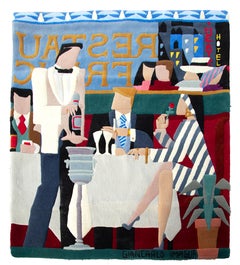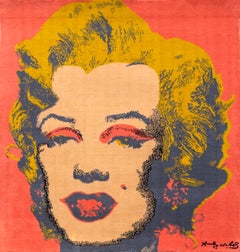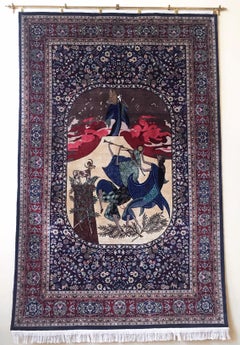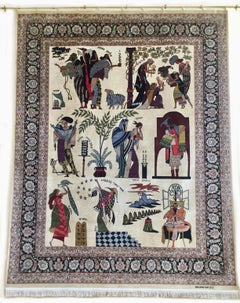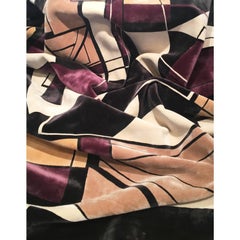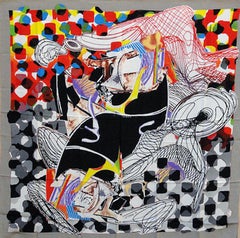RoGallery More Art
to
10
6
2
2
1
1
8
Overall Height
to
Overall Width
to
3
2
2
1
1
8
2
1
3
2
2
3
2
1
1
1
8
8
5
1
1
Dinner for Two, Art Deco Tapestry by Giancarlo Impiglia
By Giancarlo Impiglia
Located in Long Island City, NY
Art Deco rug created by American artist Giancarlo Impiglia entitled "Dinner For Two". Perfect for hanging on a wall as a tapestry. Measures 67 x 60 inc...
Category
1980s Art Deco More Art
Materials
Wool
Artichoke, Large Tapestry by Charles Chamot
By Charles Chamot
Located in Long Island City, NY
Artist: Charles Chamot, Peruvian/American (1951)
Title: Artichoke
Year: 1979
Medium: Woven Wool Tapestry, signed and numbered on label, verso
Edition: 1/6
Size: 84 x 72 inches
Category
1970s Modern More Art
Materials
Tapestry, Wool
Marilyn, Pop Art Woolen Tapestry after Andy Warhol
By Andy Warhol
Located in Long Island City, NY
A monumental limited edition Woolen Tapestry of Andy Warhol's iconic "Marilyn" published by Museum Masters International in 1997.
Artist: after Andy ...
Category
1990s Pop Art Mixed Media
Materials
Wool
Artichoke, Large Tapestry by Charles Chamot
By Charles Chamot
Located in Long Island City, NY
Artist: Charles Chamot
Title: Artichoke
Year: 1979
Medium: Woven Wool Tapestry, signed and numbered on label, verso
Edition: 1/6
Size: 84 x 72 inches
Category
1970s Modern More Art
Materials
Tapestry, Wool
Moses and the Ten Commandments (Passover), Large Tapestry Rug by Shlomo Katz
By Shlomo Katz
Located in Long Island City, NY
Artist: after Shlomo Katz, Polish/Israeli (1937 - 1992)
Title: Moses and the Ten Commandments (Passover)
Year: 2000
Medium: Woolen Carpet Tapestry
Size: 84 x 54 in. (213.36 x 137.16 cm)
Category
Early 2000s Expressionist More Art
Materials
Tapestry, Wool
Who Knows One (Passover), Large Tapestry Rug by Shlomo Katz
By Shlomo Katz
Located in Long Island City, NY
Artist: after Shlomo Katz, Polish/Israeli (1937 - 1992)
Title: Who Knows One (Passover)
Year: 2000
Medium: Woolen Carpet Tapestry, signature in the cache
Size: 120 x 95 in. (304.8 x ...
Category
Early 2000s Expressionist More Art
Materials
Tapestry, Wool
Hiropon II Bear Solar Citizen Watch, Plush by Takashi Murakami
By Takashi Murakami
Located in Long Island City, NY
Artist: Takashi Murakami, Japanese (1962 - )
Title: Hiropon II Bear Solar Citizen Watch
Year: 1998
Medium: Plush Toy and Watch
Edition: 1999
Size: 7...
Category
1990s Pop Art More Art
Materials
Polyester
Number 3, Missoni Tapestry Wall Hanging by Ottavio Missoni
By Ottavio Missoni
Located in Long Island City, NY
A woolen tapestry by Missoni circa 1980.
Artist: Ottavio Missoni, Italian (1921 - 2013)
Title: #3
Year: circa 1980's
Medium: Woolen Tapestry
Size: 21 in. x 53 in. (53.34 cm x 1...
Category
1980s Contemporary More Art
Materials
Wool
Stormwind, Large Tapestry by Charles Chamot
By Charles Chamot
Located in Long Island City, NY
Artist: Charles Chamot
Title: Stormwind
Year: 1979
Medium: Woven Wool Tapestry, signed and numbered on label, verso
Edition: 5/6
Size: 72 x 84 inches
Category
1970s Modern More Art
Materials
Tapestry, Wool
French Crystal Bronze Chandelier ca. 1910
Located in Long Island City, NY
This gorgeous chandelier is from circa 1910 with 24 candle bulbs an a multitude of gemini cut crystal. Believed to be French in origin, and will be stunning in any space. Has been re...
Category
1910s Art Nouveau More Art
Materials
Bronze
Related Items
Artist's Rug
Located in Palm Beach, FL
Artist's Rug made after Jean-Baptiste Valadie
Category
2010s Art Deco More Art
Materials
Textile, Wool, Silk
The Whale Watch
By Frank Stella
Located in Los Angeles, CA
Frank Philip Stella (born May 12, 1936) is an American painter, sculptor and printmaker, noted for his work in the areas of minimalism and post-painterly abstraction. Stella lives and works in New York City.
This hand signed silk textile scarf work is acquired directly from the publisher. Extremely uncommon to find this piece in new condition and comes in the original red silk box.
This art piece can be framed and hung on the wall or be a worn as a wearable art piece. This dazzling, large, hand signed, silkscreen on 100% Italian silk shawl was created by Frank Stella in collaboration with his longtime publisher Kenneth Tyler of the famed Tyler Graphics Studio.
"The Whale Watch...
Category
1990s Abstract Abstract Prints
Materials
Textile, Silk, Archival Ink, Digital, Archival Pigment
Kiss II (Limited Edition Reversible Cotton Blanket Wall Hanging) 59" x 70" LARGE
By Roy Lichtenstein
Located in New York, NY
Roy Lichtenstein
Kiss II, Reversible Beach Blanket/Towel, 2013
Cotton Terry
LARGE: 59 × 70 × 3/10 inches (approx. 30 x 20 when folded)
(note that the mea...
Category
2010s Pop Art Mixed Media
Materials
Cotton, Screen, Mixed Media, Textile, Laid Paper
La Conférence à la Sorbonne, 3 Juin, 1959, Lt Ed Silkscreen cover record albums
By Yves Klein
Located in New York, NY
Yves Klein
La Conférence à la Sorbonne, 3 Juin, 1959, 1959-1963
Two 12-inch vinyl records held in gatefold sleeve with silkscreen cover jacket in IKB International Klein Blue...
Category
1960s Modern Abstract Prints
Materials
Plastic, Mixed Media, Screen, Offset, Pencil, Board, Lithograph
No Reserve
H 12.7 in W 12.7 in D 2 in
A Banjo. Art Deco Era Musical Instrument With Wood Inlay. Achille Jacomoni.
Located in Firenze, IT
Banjo. Art Deco era musical instrument to be restored in inlaid wood.
Signed on the handle Achille Jacomoni, the signature is made with the pyrographed technique.
Materials: Wood, ...
Category
Early 20th Century Art Deco More Art
Materials
Metal
Free Shipping
H 22.45 in W 9.85 in D 2.96 in
Bold Abstract Latin American Screenprint Scarf Textile Art Print Josep Guinovart
By Josep Guinovart Bertrán
Located in Surfside, FL
This is a thin cotton (that is my best estimate. it does not feel like silk) scarf, woven textile, fabric piece. It is signed in the print and hand numbered.
Josep Guinovart (1927 –2007) was a Spanish Catalan painter most famous for his informalist or abstract expressionist work.
In 1941, he began to work as a decorator. Three years later, he started his studies at the Escuela de Artes y Oficios de la Llotja (Art School of La Llotja) where he stayed until 1946.
He first exhibited his work in 1948 in Galerías Syla in Barcelona. In 1951, he produced his first engravings entitled 'Homage to Federico García Lorca'. Two years later, he was awarded a grant from the French Institute to study in Paris for nine months. Here he discovered the cubist works of Henri Matisse and Pablo Picasso and travelled to Belgium, Holland and Germany.
On his return to Barcelona and after a period working as an illustrator and set designer, around 1957 he began moving towards abstract art. His work is highly unconventional and usually on a large scale, using a wide range of materials, three-dimensional objects and organic substances such as eggshell, earth and straw. He has done some amazing 3D wool tapestry wall hangings...
Category
20th Century Abstract Abstract Prints
Materials
Textile
Classic LOVE
By Robert Indiana
Located in Jerusalem, IL
This piece is from the LOVE rugs series by Robert Indiana, issued by Galerie f in 2007. This rug is an editioned, hand-carded carpet by Robert Indiana. Th...
Category
Early 2000s Pop Art Mixed Media
Materials
Fabric, Wool, Cotton Canvas
Classic Love
By Robert Indiana
Located in New York, NY
Robert Indiana’s, "Classic Love" tapestry is a wool iteration of the artist's iconic “LOVE," which began as a simple Christmas card design for the Museum of Modern Art, NYC in 1964 and has since become one of the most recognizable contemporary works created. This hand-tufted tapestry...
Category
21st Century and Contemporary Modern Prints and Multiples
Materials
Tapestry, Wool
Marco, Mid-Century Polish Tapestry by Zofia Butrymowicz
Located in Wilton, CT
Zofia Butrymowicz (1904-1987, Warsaw, Poland) was one in a select group of Polish textile artists who were first introduced in Chicago, USA in the 1970s by legendary dealers Anne and Jacques Baruch. Butrymowicz's body of work continues to influence the fiber art world to this day.
"New experiments in art have always been of interest to me" Butrymowicz once observed, "whether I agree with them or not, and therefore I never pass by and I am never indignant at any expression in art. I strongly believe that in the wide range of experiments there will also be some elements of the development of culture."
During the post-war period, when the countries of Eastern Europe were locked down behind the Iron Curtain, weavers there found materials in short supply. As a result, many of these artists turned to unconventional materials such as metal, paper and reeds. Zofia Butrymowicz, of Poland, recognized for innovative works in 60s and 70s, used heavy, irregular wools, barely spun at all. In 1969, she visited Canadian weaver, Mariette Rousseau-Vermette and her husband, painter and ceramicist, Claude Vermette, outside Montreal where the couple lived and worked. Zofia and Mariette had both been participants in International Tapestry Biennials in Lausane, Switzerland in the 60s and in Wall Hangings at the MoMA in New York in 1969.
Butrymowicz stayed with the Vermettes for several months, using Mariette’s looms to create tapestries that were displayed with Claude’s ceramics at a local gallery. Butrymowicz used wool from Mariette’s source. Mariette was particular about the color and intensity of her wool — she worked with technicians to perfect the spinning and dyeing so that the wool had a silky luster and dyed “more beautifully” than mechanically spun wool. The wool was a marked departure from the material Butrymowicz had access to in Poland. She “painted” her weavings with colors and shadings of yarns, including only a shimmering suggestion of a shape, often a circle, as she had done in the past, but the glisten and sumptuousness of the yarn in these works set them apart from her previous weavings.
Selected exhibitions: Central Museum of Textiles, Lodz, Poland; Museum of Contemporary Art, Chicago, Illinois; National Museum, Poznan, Poland; National Museum, Warsaw, Poland; Skopje Museum of Contemporary Art, Poland; Exempla, Munich, Germany; Museum of Modern Art, Pasadena, California; Pierre Pauli...
Category
1960s Modern Abstract Sculptures
Materials
Fabric, Textile, Tapestry, Wool
H 37 in W 34 in D 0.5 in
Outdoor Fire Pit - "Flame" with angled pedestal - small height
By Stefan Traloc
Located in Winterswijk, NL
Shipping costs on request.
This flame flower is the eye-catcher in your garden.
Due to the great air supply you can very quickly a beautiful fire.
The base also serves as an ash tray, has an inserted bottom, but can also be used separately as can also be used separately as a flowerpot. Of course, you can also plant the flame flower.
We manufacture the in our own locksmith's shop.
This means that we can also produce special designs, e.g. name plate with house number...
Category
21st Century and Contemporary Art Deco Sculptures
Materials
Steel
H 37.41 in W 11.82 in D 11.82 in
German Steel - "Firewood Rack" - outdoor ornament
By Stefan Traloc
Located in Winterswijk, NL
This firewood rack is on the one hand very practical to store firewood, on the other hand it is a wonderful way to add a decorative element to your garden walls.
Customization possib...
Category
21st Century and Contemporary Art Deco Sculptures
Materials
Steel
Flowers, (After) Andy Warhol -Pop Art, Tapestry, Edition, Contemporary, Design
By Andy Warhol
Located in Zug, CH
(After) Andy Warhol
Flowers, 1968
Hand Woven Wool Tapestry
183 x 183 cm (72 x 72 in)
Edition of 20
With the knotted name ‘ANDY WARHOL’ lower right and the embroidered annotation ‘WARHOL ©’ on the reverse
Published by Modern Master Tapestries, NY
Throughout art history, the flower and its symbolism have been a subject matter for many renowned artists. Andy Warhol explored the qualities of the flower image through his Pop Art prism in the Flower series of 1964, thus creating cartoon-like symbols that would be instantly recognized.
The 1964 Flower series became one of his most iconic and successful works. Based on a discovered photograph of hibiscus blossoms, Warhol drenched the flowers’ floppy shapes with a variation of vibrant colors, transforming them into psychedelic indoor décor. Playing with traditional art historical themes, Andy Warhol gave a particular twist to this historically accepted symbol of life. The electric colors of his flowers, drawn from a darker and rich undergrowth background might be the indicator of an extreme vision of life, a life lived on the edge.
Andy Warhol (1928-1987) was an American artist, a leading figure of the Pop Art movement. Using a variety of media materials from photographs up to computer-generated art, Warhol's works explore the relationship between artistic expression, celebrity, culture and advertisement that flourished by the 1960s. Emerging from the poverty and obscurity of an Eastern European immigrant family in Pittsburgh, Warhol became a charismatic magnet for bohemian New York. In 1960, he began to produce his first canvases depicting Popeye and Dick Tracy. After Marilyn Monroe’s death in August 1962, he started working from snapshots of the star’s already legendary face, which had been widely distributed by the world’s press. His choice of subjects clearly relates to an obsession with demise – his Marilyns, his Ten Lizies (created when the actress Elizabeth Taylor was seriously ill), and also his Elvis. Part of the “Death and Disaster” series, Andy Warhol´s...
Category
20th Century Pop Art Figurative Prints
Materials
Tapestry, Wool
H 72.05 in W 72.05 in D 1.19 in
